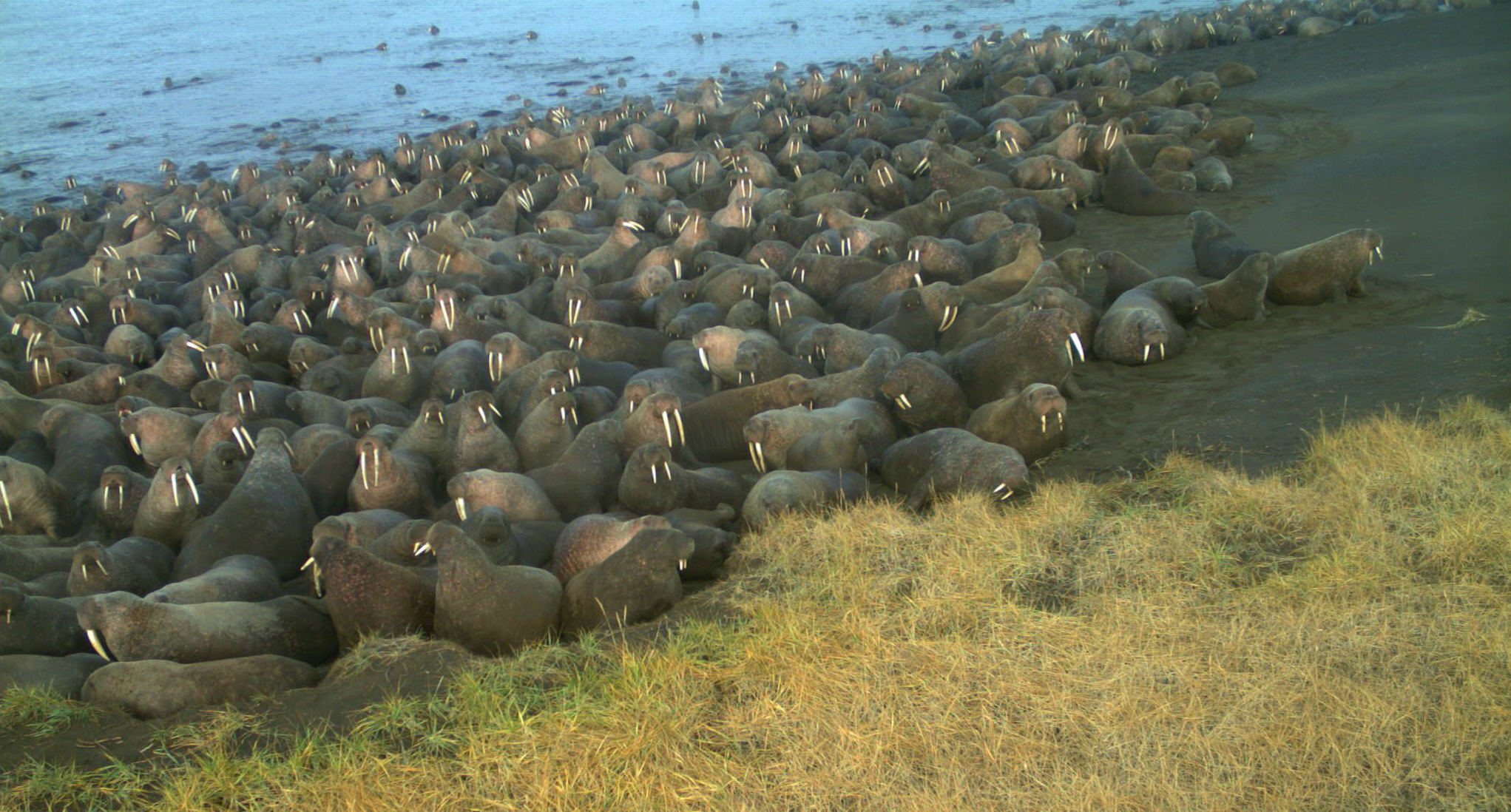Pacific walruses are again gathering much earlier than usual at Alaska Chukchi beach sites
Elsewhere in the Chukchi Sea, walrus recently received a new protected area in Chukotka.

Pacific walruses have begun massing onshore in Alaska on a Chukchi Sea beach, one of the earliest of the now-annual congregations at that site yet recorded, the U.S. Fish and Wildlife Service said.
Walruses were spotted on July 29 a beach near the Inupiat village of Point Lay and numbered about 5,000 as of Aug. 5, said Andrea Medeiros, a spokeswoman for the Fish and Wildlife Service.
Last year, after a record-hot Alaska summer and in a year that was notable for its sparsity of ice in the Chukchi, walruses also gathered at Point Lay at the end of July, at the time earliest such congregation on record. This summer’s Alaska weather and Chukchi Sea ice extent have not been as extreme, yet the walrus congregation appears to have started a day earlier than last year’s onshore crowding, Medeiros said — and much earlier than the end-of-August or September timing seen in previous years.
Pacific walruses that summer in the Chukchi, mostly adult females and their calves, have evolved to use floating ice as platforms for food foraging, resting and rearing their young. But almost every year since 2007, which was at the time a record-low year for Arctic ice extent, large numbers of walruses have flocked near the end of the melt season to the Point Lay site. Scientists say the practice is a response to climate change and retreat of sea ice. Reported walrus crowds at the Point Lay site have been as big as 40,000 to 50,000 animals.
Those mass gatherings pose dangers. The walruses are farther away from their prime sites for finding clams, worms and other foods that are foraged on the continental shelf. Additionally, the large gatherings create risks of stampedes; if spooked, the animals can rush to back into the water, causing trampling deaths, usually of small calves.
To prevent stampedes, the Fish and Wildlife Service and other entities issue annual advisories informing mariners and pilots to keep away from the walrus gathering. Those advisories are now in effect, Medeiros said.
Last year, in what was a first, two aviators were fined $3,000 apiece for flying too close to the walruses congregated at the Point Lay site in 2017 and disturbing animals.
New protections in Chukotka
On the other side of the Bering Strait, authorities have taken action to protect the population that swims between Alaska and Russia.
The government of Chukotka, the easternmost of Russia’s regions, is planning to establish some new protections at Cape Serdtse-Kamen, where walruses have been gathering in huge numbers in the fall, just before their annual migrations south from the Chukchi Sea to their Bering Sea wintering grounds.
The creation of a 4-square-kilometer reserve at Cape Serdtse-Kamen follows other actions in recent years to protect the area and the walruses that use it, according to the World Wildlife Fund. A 24-nautical buffer zone in the water was created in 2012 and the following year, the Beringia National Park was established in the Bering Strait area, including part of the southern Chukchi Sea, according to the WWF.
Designation of the new protected walrus area was at the initiative of the Russian Geographical Society’s Chukotka branch, the organization said in a statement.
Also at the initiative of the society’s Chukotka branch, a second new protected area is set to be established — a 36-square-kilometer monument at Mount Dionysius in the Anadyr region, an important area for nesting birds.
“The need for the formation of these protected areas has been discussed for several years in scientific and pseudo-scientific circles. Their formation will bring Chukotka closer to the middle of the ranking of Russian regions by area of protected areas, but also make our small contribution to Russia’s fulfillment of obligations under the signed UNESCO/UN convention on conservation biodiversity of the Arctic and the planet,” the society’s Chukotka branch said in the statement.
Suspicious deaths
Elsewhere in Alaska, there were some different signs of human-caused problems for walruses.
On a stretch of territory in the Bristol Bay region of southwestern Alaska, more than a dozen walruses turned up dead or injured in suspicious circumstances, the Fish and Wildlife Service said. The service suspects poaching is the cause, Medeiros said. The dead walruses have been found “with puncture wounds consistent with bullets,” she said.
The service is offering a reward of $10,000 for information about the person or people responsible, she said.
Unlike the walruses gathered at Point Lay and found elsewhere in the Chukchi Sea during the summer, the walruses in the Bristol Bay region are mostly adult males, according to the Alaska Department of Fish and Game species profile for the animals.